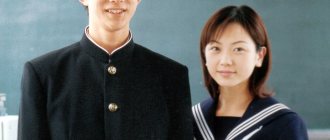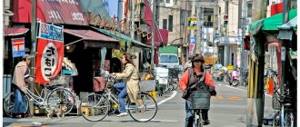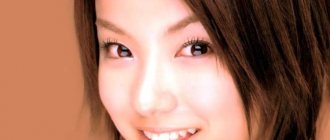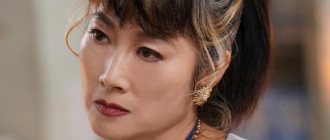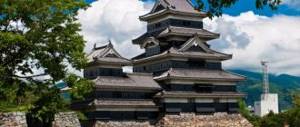Absenteeism results in a second year
I know that in Tokyo schools, a student who is simply late to class several times without a good reason is retained for the second year. That’s why my classmates often came to school sick: they coughed a lot and wore masks during classes, but they still studied. The Japanese prefer not to go on sick leave because going to the doctor is expensive. Children can stay at home only if they have a high temperature.
|
| Ekaterina's classmates |
After lessons
Interest clubs
After lessons, Japanese schoolchildren do not rush home, because they enjoy studying in school clubs based on their interests. Most often they come in two directions: sports (basketball, baseball, tennis, kendo, aikido, judo, etc.) and art (music, singing, literature, foreign languages, etc.). Bukatsu - 'classes in a circle, club, section' - is a voluntary initiative, but in fact, every student is involved in interest clubs.
The Japanese are especially sensitive to preserving traditions. Kendo is a modern fencing art designed to strengthen the will and body
Uniforms are required in Japanese schools
If kids can dress the way they want (only their backpacks are the same), then from the middle of primary school they are already required to come in uniform. The first week in Japan I wore ordinary clothes, like in Russia. But since my host dad was the director of the school where I studied, I was soon asked to wear a uniform too. This is a shirt, skirt and knee socks. When I first came in a school uniform, my classmates were delighted: they really liked that a Russian girl honored their traditions and dressed like them.
|
| Katya in her school uniform with her teacher |
The sports uniform is also the same, its color changes every year. In my class, for example, there was a red uniform. For those who studied in another parallel, it could be green or blue. This is necessary to more easily coordinate flows during public events. You can immediately see who is a first-year and who is a second-year.
|
| Sports uniforms in Japanese schools differ in color depending on the year of study. |
How many lessons are there in Japan?
In elementary school, children usually have 3-4 lessons, in middle school from 4 to 6, in high school - 6-7 lessons. The school day starts at 8:30. After 15 minutes there is a roll call and identification of truants. Classes start at 8:45. After the main classes, all kinds of courses, clubs and additional classes begin.
Homework begins to be assigned to students only in middle school. Their volume increases with each class. It is believed that high school students are the busiest people in the country. Because of this, they experience mental disorders and early health problems.
A Japanese schoolboy sleeps in class.
Japanese "bouncers" are scarier than Russians
The whole school took part in the marathon, which took place in the city of Nanai. I had to run 15 km. This was probably the most difficult thing for me. During regular lessons we mostly played basketball and volleyball. Boys study separately from girls. They are considered to be more hardy, and serious demands are placed on them. We only played dodgeball together.
|
| In Japan, entire schools take part in marathons. |
Japanese "bouncers" are scarier than ours. The guys are well developed physically, sometimes they can’t calculate their strength. They also play badminton in Japan, but with a large shuttlecock (30 cm in size). This is the most unusual game I played during physical education lessons.
|
| One of the most unusual sports games in Japan |
The shuttlecock needs to be thrown and hit with your hand to throw it to the opposite side of the field. During the flight, it turns around at the other end, and a person from the opposing team must hit it and bring it back. The most important thing is to guess the flight path. Some feathers are curved and this is difficult to do.
Higher Japanese education
There are 600 universities in Japan, more than half of which are private. Admission takes place in 2 stages: writing a general test and entrance exams directly at universities. The training lasts 4 years. Universities in Japan have a strict hierarchy; the most prestigious universities will be discussed later.
At universities there is a clear boundary between general scientific and specialized subjects. For the first 2 years, the student studies the first type of discipline and, if desired, can change his specialization. For the next 2 years he studies disciplines in his chosen specialization.
If the student wishes to continue his studies and meets all the requirements, he can obtain a master's degree (2 years of study). In addition to regular students, the university accommodates “free-lance students”, “transfer students” and “research students” at will. They can attend a number of disciplines together with students.
“My classmates addressed me as “you”
In Japan, no one calls each other by their first names. It is believed that this is a personal space that cannot be violated. The exception is best friends and, perhaps, classmates. The rest are usually called by their last names. At first, my classmates addressed me as “Katya-san.” The Japanese use the suffix “san” in everyday communication; it’s kind of like addressing someone as “you”. I didn't like it, and I asked them not to call me that.
During breaks, we most often talked about boys and relationships. The guys are discussing anime or computer games. Someone is doing homework. In Japan, little is known about Russia. Basically, all their knowledge is vodka, bear, Putin, kokoshnik (which, by the way, they call “Katyusha”). They think that Russia is Moscow and Siberia, and that’s it, nothing more. So I told them about Yekaterinburg and how beautiful it is in the Urals.
|
| Photo booths are popular among Japanese schoolchildren. |
Beginning of the school year
Our school has four floors, and the layout of the classes inside also corresponds to the “internal levels”: the first and second grades study on the first floor, the third and fourth - on the second, the fifth and sixth - on the third. On the fourth floor they have classrooms for natural science (essentially chemistry), works, etc. As in Russia, in Japan in the lower grades there is a class teacher who teaches all lessons at once. With the transition to the upper floor, the class chooses a new motto, for example, this: “Be like the sun: so that not only you yourself feel good and warm, but so that others can also be warm.” In Japanese, “sun” is “taiyo:”; to write it in alphabet, you need four characters: “ta”, “i”, “yo” and “u” (for the length of the syllable “yo”). And for each of these four signs, the children came up with another decoding (my translation, somewhat free): “ta” sukeau - akarui nakama - “to be friends, help each other” “i”ronna koto-ni chosen si yaritogeru - “to set different goals and achieve them" "y"ku manabi yoku asobe - "have studied well - have a good rest" "u"so, ijime, kenka wa shinai - "Don't lie, don't mock, don't fight" As at the beginning of every year, the children wrote their goals for the year in school and in life. This year the picture was a rocket, in the window of which you had to draw yourself. Under the image of yourself you had to write your personal motto (thus, there were three mottos: school, class and personal). Goals, as a rule, are simple and achievable: study well, learn to run fast, write beautifully and accurately - this is at school, and at home - help around the house, eat breakfast quickly, remember to wash your hands before eating, etc.
“I didn’t know how to behave with Japanese teachers”
Some teachers at my school were strict. At first I was afraid of them and didn’t know how to behave. The most strict teacher was the history of the Japanese language. He always looked at the class over his glasses. There was also a biology teacher - on the first day he entered the class, saw that someone was talking, and said a phrase that can be translated into Russian as “shut up!” I didn’t understand why he spoke so rudely, but my classmates explained to me that “this is normal.” They respected Tamamori Sensei for his approach to work, although his methods were very different from those of other teachers. He even allowed me to shorten his name because I am a foreigner. I could call him not like everyone else (Tamamori-sensei), but Tama-chan (“chan” is a diminutive suffix that is used in relation to close friends, but not to teachers).
School program
The teaching program varies from school to school, but is based on standards approved by the Ministry of Education. Responsibility for funding, teacher staffing and the school curriculum lies with local authorities.
In Japan, children begin to attend school when they reach the age of six. Before this, children usually go to kindergarten. By the time they enter school, children should have basic arithmetic and be able to read hiragana and katakana.
In elementary school, children study Japanese, mathematics, science (physics, chemistry, biology), social studies (ethics, history, etiquette), music, fine arts, physical education and home economics. By the end of primary school, children must, in particular, learn 1006 Kanji characters from the 1945 characters on the state list.
In secondary school, English and several special elective subjects are added to the list of subjects. The composition of these subjects depends on the school. The most difficult subjects are mathematics and languages - Japanese (learning kanji) and English.
The high school curriculum is slightly more varied than the middle and primary school curriculum, but students are given more opportunities to specialize in a particular area of study.
Students bring their own lunches
There are no canteens in Japanese schools; food must be brought. In Japan there is such a thing as “obento”. This is a lunch box that parents put together. My host mother made me delicious sandwiches with bread, mayonnaise, lettuce and eggs, and my classmates brought traditional food with them to school. For example, rice wrapped in an omelette, sometimes with curry (this seasoning is very popular in Japan). Someone was cooking pasta with seaweed.
Sometimes after school we would run to the Seven Eleven store (they are distributed throughout Asia) and buy onigiri. These are stuffed rice triangles wrapped in seaweed. My favorite onigiri were with shrimp or tuna and mayonnaise. I gained 5 kg in a month in Japan because at home we always ate rice for dinner.
|
| There are no canteens in Japanese schools. |
Exams
The main problem of Japanese schools is the exhausting exams, each of which takes several hours of hard work and much more time in preparation for it. From time to time they become the cause of suicide among schoolchildren.
Middle and high school students take exams at the end of each term and midway through the first and second terms. There are no exams in primary school. Mid-term exams are held in Japanese, mathematics, English, science and social studies. At the end of terms, exams are held in all subjects studied.
A week before the start of exams, club meetings are canceled to allow students to prepare for exams. Examinations usually take the form of written tests. Exams are graded using a percentage system. The highest score is 100 points.
Japanese often go to work right after school
Higher education in Japan is paid. Some of my classmates wanted to go to university in Sapporo, a large city on Hokkaido (the northernmost island). But this is difficult to do, especially if you live in a small town. Therefore, more often than not, after school, the Japanese begin to look for work.
To get a job at a company, you need to go through an interview. Children who decide that they will not go to university begin to prepare for it in advance - in high school. When they come for an interview, they give their serial number, first name, last name, school from which they came, and age. If they like them, the employer conducts a special course for them. After that, they become assistants, but can then be promoted. For a Japanese, career is more important than family. Many even get married for show, so that they are more respected at work.
Continuity is important in Japan. If you are the son of a doctor, then by birthright you are obligated to become a doctor (doctors in Japan earn the most). Parents, of course, will help you get a higher education - most likely at the University of Tokyo. There are, of course, exceptions when children of doctors want to become, for example, writers, but this is usually not approved. There are entire families who perform in kabuki theaters. This is another profession that is inherited in Japan. It is considered very prestigious, so boys study in private, elite schools from childhood.
You can find out how to become an AFS student on the organization’s official website.
There are no cleaners in Japanese schoolsAuthor:
Polina Strelnikova
School in Japan is divided into three levels:
Primary school
(grades 1-6) - shogakko,
Middle school
(grades 7-9) - chugakko,
High school
(grades 10-12) - kotogakko.
The numbering of classes is not continuous, as in Russia, but internal - “first grade of elementary school,” “second grade of high school,” and so on. Parallels are usually indicated by letters of the Latin alphabet: 1-A (first parallel of the first class), 1-B (second parallel of the first class) and so on, or by numbers: 1-1, 1-2 and so on.
How to choose the right school for your child? Individual parent counseling
Primary and secondary schools
in Japan they are compulsory for everyone and free. High school is not compulsory, but about 95% percent continue their studies after high school. 48% of high school graduates go on to college (2 years) or university (4 years).
Tuition in high school and university is always paid, but in public institutions it is cheaper. There are also fee-paying private primary and secondary schools. In all paid institutions you can study for free or get a big discount if you win a scholarship competition.
Japanese mothers tend to be very attentive to their children's success. They maintain close contact with teachers, participate in the life of the school, and in case of illness of children, sometimes even go to classes instead of them and take notes on lectures. Such fanatical mothers are called “kiyoiku mama.”
At the same time, the children themselves often “sit on the neck” of their parents until they are about 25-30 years old, when they begin to earn enough to feed themselves.
Academic year
The school year in Japan is divided into three trimesters and begins on April 6.
The first trimester lasts until July 20, then the big summer holidays begin, the second trimester begins on September 1, the winter holidays start from December 26, and the last, third, trimester lasts from January 7 to March 25. Then there is a short spring break, during which there is a transition from class to class. The exact start and end dates of terms vary from school to school.
The beginning of the school year in April is due to the fact that at this time in Japan spring comes into full force and cherry blossoms begin to bloom. There is a movement to move the start of the school year to September 1, but it is not very popular. During the holidays, students receive homework. Sometimes they continue to study during the holidays (in special courses), if they did not study well enough during the trimesters. It is recommended that elementary school students keep “picture diaries” during the holidays - pictures fill in gaps in kanji knowledge and develop the student’s ability to write and draw. training in Japan ,
but every second Saturday is considered a day off.
School program
The teaching program varies from school to school, but is based on standards approved by the Ministry of Education. Responsibility for funding, teacher staffing and the school curriculum lies with local authorities.
In Japan, people begin to attend school when they reach the age of six. Before this, children usually go to kindergarten.
Kindergarten in Japan
Kindergarten in Japan
By the time they enter school, children should have basic arithmetic and be able to read hiragana and katakana. In elementary school, children study Japanese, mathematics, science (physics, chemistry, biology), social studies (ethics, history, etiquette), music, fine arts, physical education and home economics. By the end of primary school, children must, in particular, learn 1006 Kanji characters from the 1945 characters on the state list.
In secondary school, English and several special elective subjects are added to the list of subjects. The composition of these subjects depends on the school. The most difficult subjects are mathematics and languages - Japanese (learning kanji) and English. The high school curriculum is slightly more varied than the middle and primary school curriculum, but students are given more opportunities to specialize in a particular area of study.
Timetable
Just like in Russia, but unlike the USA, primary and secondary schools are usually located within a 5-10 minute walk from the student's home. Of course, in rural areas the school may be significantly further away. School classes usually start at half past eight in the morning. Every Monday, before the start of classes, students line up and the school principal speaks to them for 15 minutes. On other days, this time is reserved for school-wide announcements and attendance. Attending school diligently is of great importance in Japan. However, a truant may run away from school after the first lesson.
The duration of lessons in elementary schools is 45 minutes, in middle and high schools - 50 minutes. Between lessons there are small breaks of 5-10 minutes, after the fourth lesson (at about half past one) there is usually a long break for lunch - about 60 minutes. Students who try to start eating breakfasts brought from home before the official start of lunch are punished, especially if they eat during lessons. In elementary school there are rarely more than four lessons a day. In high school their number can reach up to six.
In elementary school there is no homework, but in middle and high school there is a lot of homework, so despite having days off, Japanese high school students are the busiest people in the country.
Organization of studies
Unlike Russian schools, in Japan each class is assigned its own classroom (in Russia, the classroom is assigned to the teacher). Therefore, it is not the students, but the teachers who walk from office to office between lessons. The office assigned to the class is signed with the appropriate sign.
There are different teachers for each grade and each subject, although in small schools this may not be the case. Japanese schools often do not have cafeterias or locker rooms, so students have to eat lunch and hang their clothes in the classrooms. At the end of lessons, students themselves completely clean the school and school grounds. There are no cleaners in Japanese schools. Joint field trips and excursions to ancient Japanese cities and temples are often organized for schoolchildren. Such excursions usually last up to three to four days. For most middle and high schools, school uniforms are required. Each school has its own, but in reality there are not many options. Usually this is a white shirt and dark jacket and trousers for boys and a white shirt and dark jacket and skirt for girls, or sailor fuku - “sailor suit”. Primary schoolchildren, as a rule, dress in ordinary children's clothing.
Clubs and courses
Participation in the activities of school clubs (kai) is considered an important part of studying in secondary school. Typically, their activities are related to either sports or art, take place after classes and are organized by the students themselves. Aside from the obvious benefits they provide, clubs are also breeding grounds for hazing, where older students bully younger students to get better results (or just to make fun of them).
At the very beginning of the school year, the leadership of the clubs puts out their “advertising” for seventh grade students. Almost every seventh grader enrolls in one or more clubs and remains in them throughout their entire time in high school.
In addition to the school itself, most students attend paid preparatory courses called juku, which help them better prepare for passing school exams. Juku classes usually take place in the evening, two to three times a week.
Exams
The main problem of Japanese schools
- These are grueling exams, each of which takes several hours of hard work and much more time in the process of preparing for it. From time to time they become the cause of suicide among schoolchildren.
Middle and high school students take exams at the end of each term and midway through the first and second terms. There are no exams in primary school. Mid-term exams are held in Japanese, mathematics, English, science and social studies. At the end of terms, exams are held in all subjects studied.
A week before the start of exams, club meetings are canceled to allow students to prepare for exams. Examinations usually take the form of written tests. Exams are graded using a percentage system. The highest score is 100 points.
After high school
The transition from middle school to high school is based on exam results. First, based on his school performance, the student receives a list of high schools to which he has a chance of admission. He then takes a transition exam, and based on his results and previous performance, the question of which high school the student will enter is decided.
Good students end up in prestigious high schools, bad students end up in run-down schools for those who do not intend to pursue higher education. Such schools focus on home economics, agriculture, and so on. Their graduates have no career prospects.
Those who do not choose to enroll in high school can enroll in five-year “technical colleges”—vocational schools. However, entering them is not so easy - there is a lot of competition for the best of them, since skilled workers are highly valued in Japan. Some technical colleges are owned by large firms, and their graduates are immediately employed.
Academy
In addition to regular public schools, there are also private fee-paying academy schools (gakuen), as well as “national” schools
- schools of national importance. To enter them, you need to pass special exams in conditions of great competition. On the other hand, they have better educational programs, and many of them provide non-competitive admission to high school or university.
Typically, the children of the Japanese elite study at academy schools: politicians, businessmen, diplomats, and professors from famous universities. Those who receive scholarships to study at academies often turn out to be “black sheep” and sometimes become the subject of bullying by classmates.
Some academies do not require wearing a school uniform.
Universities and colleges
The main criterion when choosing a university is prestige. Those who were able to graduate from a prestigious educational institution are hired for almost any job. It is believed that a capable and diligent young man can understand any matter that is entrusted to him.
Instead of a university, you can enroll in a two-year college that provides specialized education. About 90% of Japanese girls enroll in them and receive “low-level” female professions there: nurses, kindergarten teachers, primary school teachers, qualified housewives, seiyuu actresses.
Admission to the university takes place in two stages. At the first, high school graduates take a national exam. Based on its results, they submit applications to the university of their choice. There the issue of their admission to the entrance exams themselves is decided, which they then pass.
The most prestigious universities include public universities in Tokyo, Kyoto, Osaka, Sapporo, Nagoya, Fukuoka, Sendai, as well as private universities: Waseda, Keio, Chuo, Meiji in Tokyo, Kansai University in Osaka and Ritsumei in Kyoto.
The most prestigious is the State University of Tokyo (Todai), founded in 1877 and occupying an area of 30 hectares in the center of Tokyo. About 10 thousand people study within its walls at the same time, 2,000 of them are foreigners. 90% of Todai's graduates take their place among the country's elite; two of its graduates became Nobel Prize laureates in literature (Kawabata Yasunari and Oe Kenzaburo).
Those who did not pass the exams at the desired university can take the exams in a year or two. At this time, applicants either study in special yobiko courses, or work, or combine the first and second.
Unlike school, studying at university is a time of relative freebies. The set of disciplines is chosen by the student himself, naturally, within certain limits. As a rule, there are no large term papers or dissertations; you just need to write reports of several pages. Therefore, students are practically not involved in serious scientific work. And if they are involved, then as assistants, but not as independent researchers. Many students devote their time to studying to find a job and live with a variety of extra jobs.
All about higher education
After graduating from university, you can enroll in a 2-3-year graduate school and receive an academic degree after graduation.
How to choose the right school for your child?
Individual parent counseling
TAGS: There are no cleaners in Japanese schools, education, education in Japan, Japanese children, Japan, Japanese school, holidays in Japanese schools, Japanese girls, boys, boys holiday, school in Japan, Japanese education, how to marry a Japanese man, in Japanese schools have no cleaners, school year in Japan, school curriculum, lesson schedule, after school, universities in Japan, colleges in Japan
年休 (Nenyku)
Each teacher is given a discrete number of "vacation days" to use throughout the year. This is called "Nenkyu". If a teacher is not on vacation, he must go to school, regardless of whether there are duties that day or not.
In this sense, they do not have "vacation" periods (except on national holidays), but they can distribute the annual leave in a way that is most convenient for them.
Instead of using their vacation time for actual vacations, Japanese teachers use their vacation hours or even minutes for urgent matters during the school year (because “you should be ashamed of missing work”).
Another day's “board of shame.”
So what does this chart currently say?
TEACHER 1: 1 day TEACHER 2: 2 hours TEACHER 3: 4 hours TEACHER 4: 3 hours 45 minutes Wait, what? Two hours? Four o'clock? Three hours and forty-five minutes?
Why are these numbers on the board again? Vacation? Three hours and forty-five minutes of vacation? Yes, three hours and forty-five minutes from vacation. Why? Well, that's a tough question.
You see, teachers in Japan usually come to work every day before eight o'clock (if classes are from 8:30) and stay until the evening (until eight, nine, ten or later, they say that the especially diligent ones stay overnight).
Cost of living in Tokyo. Prices in rubles, as of April 2020.
Apparently teachers' work hours officially end much earlier (at four?), but teachers "volunteer" and often for free give up their time beyond what is required of them in their contracts to stay and help out with the school's various club activities and sports teams. (I LOVE FOOTBALL / I WANT TO BE A FOOTBALL PLAYER / FOOTBALL IS FUN).▼
Many teachers also work at least one day on the weekend with their extracurricular activities (if not both days).



